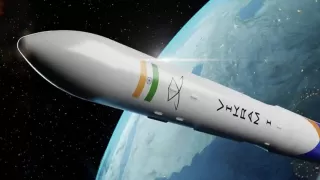After the successful landing of Chandrayaan-3 on the Moon, India's space research agency ISRO has now successfully launched the solar mission 'Aditya-L1' from the Satish Dhawan Space Center in Sri Harikota to study the Sun. With this, a new era of space exploration has started in the galaxy.
This mission, like Chandrayaan, will first orbit the Earth at high altitude and then it will fly more rapidly towards the Sun. 'Aditya-L1' will reach a height of about 1.5 million kilometers from the Earth. Unless it overcomes the gravitational force of the Earth and the Sun, it will stop at a point in between (Lagrange Point) which is named L1 in scientific language.
'Aditya-L1' spacecraft will cover this distance in about four months. From here he will study various activities of Sun, internal and external environment etc. The United States has previously sent a similar mission closer to the Sun in the L-2 region. Aditya L1' is being considered a major step in India's space research and exploration. The distance from Earth to the Sun is approximately 15 crore kilometers. Is.
According to a report by news agency Reuters, India has opened the work of space launch to private companies and possibilities of foreign investment in this field are being explored. The government aims to increase its share in the global launch market by five times in the next decade. As the space sector is turning into a global business, the country's hopes rest on the success of ISRO to prove its capability in this sector.
India's growing influence in space
On August 23, India became the fourth country in the world after the United States, Russia and China to land Chandrayaan-3 on the Moon. This spacecraft has landed on the south pole of the Moon, where no mission of any country has reached so far. This is a great achievement of Indian scientists.

Professor Dr. Akash Sinha of Shiv Nadar University says, "Chandrayaan 3's rover has been designed in a very smart way. This small machine with six wheels is like a car. The rover takes its own decisions, "Chooses its own routes. Monitors the atmosphere and temperature of the moon's surface, etc. It is doing its job well."
India started space research in the 1950s and 1960s at a time when the country was facing the challenge of poverty and poverty. When it launched its first rocket in 1963, no one had any illusion that it was competing with developed countries like America and Russia.
Comparison with the budget of the film 'Interstellar'
But today India is the fifth largest economy in the world. In space technology it now definitely stands in the league of the world's leading countries, the United States, Russia, China and the European space agencies.
India has spent about $70 million on the Chandrayaan-3 mission, which is less than half of the $131 million spent on Christopher Nolan's 2014 space mission film 'Interstellar'.

Space research and development is generally considered an adventure for rich countries. But India's success has also created a new enthusiasm and passion in the field of science and technology in the emerging countries of the world.
No one country has a monopoly on research on the Moon or the Sun and the knowledge obtained from it. It is dedicated to human development and humanity across the globe.
Whatever Indian scientists get from the research of Moon and Sun, the whole world will benefit from it. Whatever progress the world has made has been possible only because of scientific research and new inventions.
What do common people say
The success of Chandrayaan has created a new stir and enthusiasm in India. Student Ada Shaheen says, "It is a matter of pride for the whole country. It is also a sign that India is developing rapidly."
A young man named Shah Rukh Khan expressed his feelings in this way, "I am happy that India has taken a big leap in space. My childhood dream has come true. I used to see pictures of the American flag on the moon since childhood." I wished that the flag of India could also reach there. My childhood dream came true."
However, along with these thoughts he also gives some suggestions. He says that scientists should focus on solving problems on Earth before space exploration. According to him, nothing will be achieved by such a space mission and it is an illusion to divert the attention of the people from the real problems of the country. Faraz Fakhri is a film producer. He says that the success of Chandrayaan 3 gave a big boost to the private space sector.
"The rover has detected sulfur and other mineral deposits on the moon in a few days. It also recorded unusual temperature changes between day and night. This space mission is a great success and I think India is now in the space race." Has joined."
Private space companies with ISRO
Space research and development work in India is not done only by the Indian Research Organization (ISRO). In recent years, several private space technology companies have emerged in the country.
These start-up companies are moving very fast in the space sector. Many of them are gaining international importance. After Chandrayaan-3's landing on Moon, ISRO Director thanked ISRO scientists for this achievement and also appreciated many private space companies of India.

These private technology companies have played an important role in this space mission. Until a few years ago, the work of space research and development was only in the hands of ISRO and its affiliated scientific technology institutes, but in 2020, the Modi government opened the space technology sector to private companies.
Fast growing startup
In the last four years, about 150 private space companies have come into existence. These tech startups are growing very fast. Billions of rupees are being invested in these companies.
The role of high technology startups and private companies is increasing in ISRO's space missions. These companies are also moving forward on their own. In 2022, a private company called 'Skyroot' launched its satellite into space on a rocket made in India.
This was the first time that an Indian private company had successfully launched its satellite into space with its own rocket. This Hyderabad-based company is preparing to send a big satellite into space by the end of this year.
Russia and China left behind
It is cheaper to send satellites from India compared to America and Europe. Due to this, the importance of these private space companies has increased even more. Due to global political reasons, Russia and China are now lagging behind in space trade. In such a situation, along with the Indian Space Research Organization (ISRO), these private Indian space companies are also attracting the attention of the world.

According to experts, the market for sending satellites into space is currently worth six billion dollars. It is expected to triple in the next two years. According to a report in the American newspaper New York Times, Elon Musk's 'SpaceX' company has emerged as a new challenger in the market. SpaceX uses space shuttle rocket ie reusable space rocket to go into space.
It is capable of carrying heavy weight and large sized planets into space, due to which launching satellites through this rocket is cheaper than in India.
Indian private companies are now working in specialized areas of space technology. They are not only collaborating with ISRO in various space fields, but now they are also helping American and European space agencies.
ISRO is now getting the right to work more and faster on new missions in collaboration with these private companies.
Also Read: What is a hydrogen car and how do they work?




























